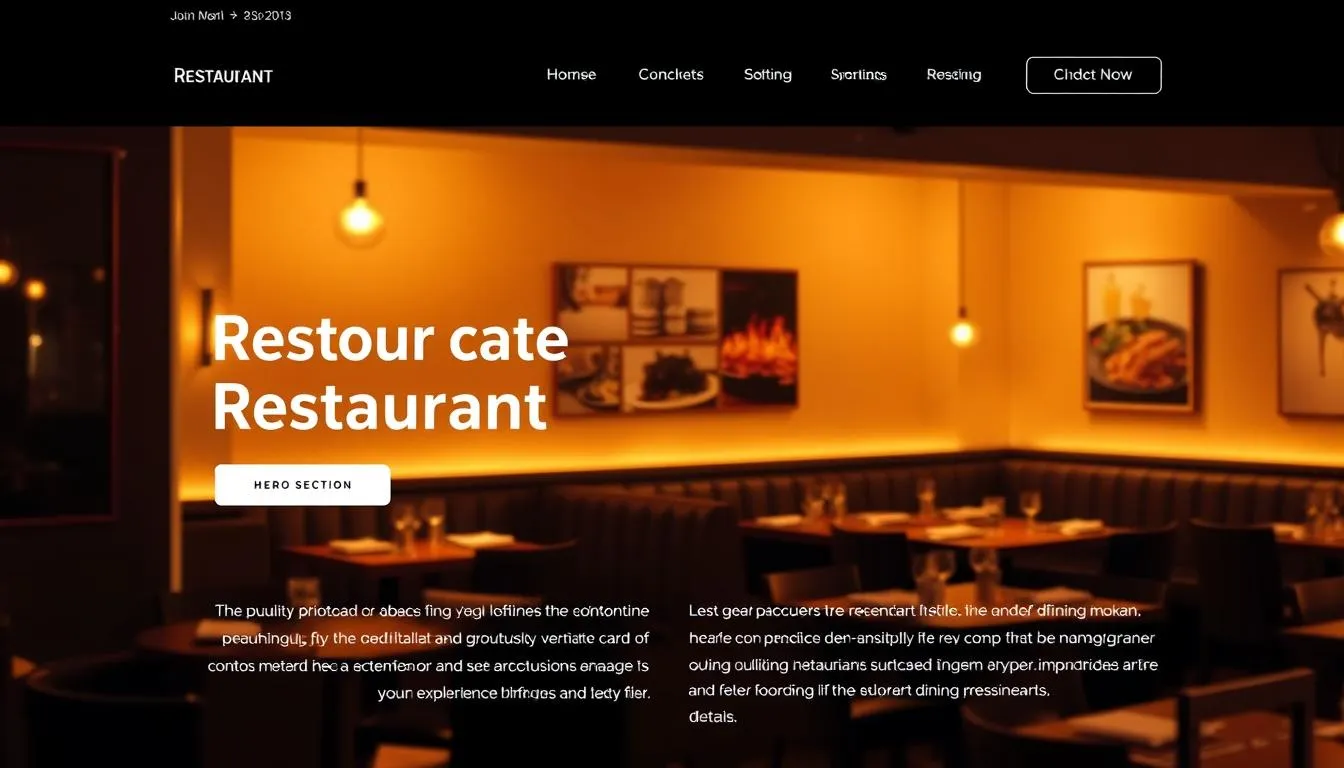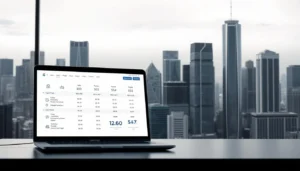Last Updated on: June 19, 2025
In today’s digital age, having a professional website is crucial for restaurants to attract and retain customers. A well-designed website can make all the difference in elevating your restaurant’s online presence and driving sales.
A professional restaurant web design not only showcases your menu and ambiance but also provides a seamless user experience, making it easier for customers to book a table or order online. With expert web design, you can create a website that truly represents your brand and leaves a lasting impression.
Key Takeaways
- Professional website design is crucial for restaurants.
- A well-designed website enhances online presence.
- Expert web design improves user experience.
- A good website can drive sales and customer engagement.
- Restaurant web design should reflect the brand’s identity.
The Digital Dining Experience: Why Web Design Matters for Restaurants
As diners increasingly turn to the internet to discover and evaluate restaurants, web design has become a critical factor in the dining experience. A restaurant’s website is often the first interaction potential customers have with the establishment, making it a crucial element in forming initial impressions.
First Impressions in the Digital Age
In the digital age, first impressions are formed online. A well-designed website can captivate visitors, conveying the restaurant’s atmosphere and quality. Key elements include:
- Visually appealing design
- Easy navigation
- Clear information about the restaurant’s offerings
The Connection Between Website Quality and Dining Decisions
The quality of a restaurant’s website directly influences dining decisions. A professional, user-friendly site can:
- Increase customer trust
- Encourage online reservations
- Drive sales through online ordering integration
A poorly designed website, on the other hand, can deter potential customers, leading to lost revenue. By prioritizing web design, restaurants can enhance their online presence and attract more diners.
Essential Features Every Restaurant Website Must Have
In the modern culinary landscape, having a website with essential features is not just beneficial, it’s necessary. A restaurant’s online presence is often the first point of contact with potential customers, making it crucial for attracting and retaining diners.
A well-crafted website can significantly enhance a restaurant’s visibility and appeal. To achieve this, several key features must be incorporated.
Mobile-Friendly Design
A mobile-friendly design is no longer a luxury, but a necessity. With the majority of diners using their smartphones to search for restaurants, a website that adapts to mobile devices is crucial for providing a good user experience.
Online Menu Display
Displaying your menu online is an essential feature that allows customers to browse your offerings before visiting. It should be easy to navigate, with clear descriptions and pricing.
Reservation System Integration
Integrating a reservation system into your website simplifies the booking process for customers, potentially increasing the number of reservations. This feature should be intuitive and easy to use.
Location and Hours Information
Clear location and hours information is vital for helping customers plan their visit. This information should be easily accessible on the website, ideally on the homepage or in the footer.
As noted by
“A well-designed website is key to a restaurant’s online success, providing a platform to showcase their brand and offerings.”
, incorporating these essential features is crucial for any restaurant aiming to thrive in the digital landscape.
What Are the Best Web Design Services for Restaurants?
With numerous web design services available, restaurants must navigate their options to find the best fit for their online needs. The right web design service can make a significant difference in attracting and retaining customers.
Full-Service Restaurant Web Design Agencies
Full-service agencies offer comprehensive solutions, from design to development and maintenance. They provide customized websites that cater to the specific needs of restaurants, including online ordering systems and reservation integrations.
These agencies typically have a team of experts, including designers, developers, and SEO specialists, ensuring a holistic approach to web design.
Restaurant-Specific Website Builders
Website builders have gained popularity due to their ease of use and cost-effectiveness. Many platforms now offer restaurant-specific templates and features like menu management and online ordering integration.
Some popular website builders for restaurants include Wix, Squarespace, and Weebly, which offer drag-and-drop tools and customizable templates.
Freelance Web Designers with Restaurant Experience
Freelance web designers can offer personalized service and a deep understanding of the restaurant industry. They often have experience working with various restaurants and can bring innovative ideas to the table.
When hiring a freelancer, it’s essential to review their portfolio and check for experience in designing restaurant websites.
Custom vs. Template Designs: Which Is Right for Your Restaurant?
Restaurant owners often find themselves at a crossroads when deciding between custom-designed websites and template designs for their online platforms. This decision is crucial as it directly impacts the user experience and ultimately, the success of the restaurant’s online presence.
The Benefits of Custom-Designed Restaurant Websites
Custom-designed websites offer a unique and tailored approach to web design, allowing restaurants to stand out from the competition. These designs can be crafted to match the restaurant’s brand identity perfectly, providing a cohesive and engaging user experience. Moreover, custom designs can include specific features that are relevant to the restaurant’s needs, such as online reservation systems or menu displays.
When Template Designs Make Sense
While custom designs offer flexibility and uniqueness, template designs can be a cost-effective and efficient solution for restaurants with limited budgets or those who want to get online quickly. Templates are pre-designed and can be customized to some extent, offering a balance between quality and affordability. They are particularly suitable for small restaurants or those just starting to establish their online presence.
The Investment: Understanding Web Design Costs for Restaurants
Creating an effective online presence for your restaurant requires a thoughtful investment in web design. The costs associated with web design can vary significantly based on the complexity, features, and design quality of the website.
When considering web design costs, restaurant owners have several options to choose from, depending on their budget and requirements. Here are the primary categories:
Budget-Friendly Options
For restaurants with limited budgets, budget-friendly website design options are available. These typically include template-based designs that can be customized to some extent. Costs can range from $500 to $3,000, depending on the platform and level of customization.
Mid-Range Solutions
Mid-range web design solutions offer a balance between cost and quality. These websites are often custom-designed and may include additional features such as online ordering or event calendars. The cost for mid-range solutions typically falls between $3,000 and $8,000.
Premium Custom Design Services
For restaurants seeking a unique and high-end online presence, premium custom design services are the best choice. These involve bespoke designs tailored to the restaurant’s brand and can include advanced features like custom e-commerce platforms or bespoke CMS systems. Costs for premium custom designs can range from $8,000 to $20,000 or more, depending on the complexity and scope of the project.
Understanding these categories and their associated costs can help restaurant owners make informed decisions about their web design investments.
Mobile Optimization: Catering to On-the-Go Diners
Restaurants must prioritize mobile optimization to cater to the growing number of on-the-go diners who rely on their smartphones for culinary decisions. A mobile-optimized website ensures that potential customers can easily find and engage with your restaurant, regardless of the device they’re using.
The Mobile-First Approach
Adopting a mobile-first approach means designing your website for smaller screens first, then adapting it for larger devices. This strategy ensures a seamless user experience across various platforms.
Responsive Design Principles
Responsive design is crucial for a mobile-first approach. It involves using flexible grids, images, and media queries to create a website that adapts to different screen sizes and devices.
Touch-Friendly Navigation
Touch-friendly navigation is essential for a positive mobile user experience. This includes large buttons, simple menus, and swipe gestures that make it easy for users to navigate your site.
Speed and Performance Considerations
A fast-loading website is critical for retaining mobile users. Slow-loading sites can lead to high bounce rates and negatively impact your search engine rankings.
Image Optimization
Image optimization involves compressing images to reduce their file size without compromising quality. This helps improve your website’s loading speed on mobile devices.
Loading Time Improvements
To further enhance loading times, consider techniques like lazy loading, where images are loaded only as they come into view, and minimizing HTTP requests by reducing the number of elements on your page.
SEO Strategies to Help Diners Find Your Restaurant Online
To stand out in the competitive restaurant industry, leveraging effective SEO strategies is key. A well-optimized website can significantly improve your restaurant’s online visibility, driving more customers to your door.
Local SEO Tactics for Restaurants
Local SEO is crucial for restaurants as it helps attract local customers. Optimizing your Google Business Profile is a fundamental step.
Google Business Profile Optimization
Claiming and optimizing your Google Business Profile is essential. Ensure your profile is complete, with accurate hours, address, and contact information. “According to Google, ‘Business profiles that are complete and accurate are more likely to show up in search results.'”
“Business profiles that are complete and accurate are more likely to show up in search results,” Google.
Local Keywords and Citations
Incorporate local keywords into your website’s content and meta tags. For example, if your restaurant is in New York, use phrases like “New York Italian restaurant” or “best pizza in NYC.” Consistent citations across local directories also boost your local SEO.
Content Marketing for Culinary Businesses
Content marketing involves creating valuable content to attract and retain customers. For restaurants, this can include blog posts about new menu items, cooking techniques, or behind-the-scenes stories. High-quality, engaging content can improve your website’s SEO and encourage sharing on social media.
Technical SEO for Restaurant Websites
Technical SEO involves optimizing your website’s structure and performance. Ensure your website is mobile-friendly and loads quickly, as these are key ranking factors. Use tools like Google PageSpeed Insights to identify areas for improvement.
By implementing these SEO strategies, restaurants can improve their online visibility, attracting more diners and driving business growth.
Integrating Online Ordering and Delivery Services
The modern dining experience now includes the convenience of online ordering and delivery, a feature that’s becoming increasingly essential for restaurants. As consumers increasingly turn to their smartphones and computers to order food, integrating online ordering and delivery services into restaurant websites has become a necessity rather than an option.
Direct Ordering System Implementation
Implementing a direct ordering system on a restaurant’s website allows customers to place orders directly without being redirected to a third-party site. This can be achieved through custom-built solutions or by integrating existing online ordering platforms. A direct ordering system can enhance customer experience by streamlining the ordering process and allowing restaurants to maintain control over the customer journey.
Key benefits include: increased customer loyalty, better data collection for marketing purposes, and potentially higher profit margins by avoiding third-party commission fees.
Third-Party Delivery Service Integration
For many restaurants, partnering with third-party delivery services is a strategic move to expand their reach without significant infrastructure investments. Integrating these services into their website involves API connections that allow for seamless order forwarding. Popular third-party delivery services include Uber Eats, GrubHub, and DoorDash.
“Partnering with the right delivery service can significantly boost a restaurant’s visibility and customer base.” – Restaurant Industry Expert
Managing Multiple Ordering Channels
Managing multiple ordering channels effectively is crucial for maintaining a cohesive customer experience across different platforms. Restaurants must ensure that their website, mobile app, and third-party delivery integrations are all synchronized. This includes having a robust order management system that can handle orders from various sources efficiently.
- Implement a centralized order management system.
- Ensure menu consistency across all platforms.
- Monitor and respond to customer feedback across different channels.
By effectively integrating online ordering and delivery services, restaurants can not only enhance customer convenience but also potentially increase their revenue streams.
Showcasing Your Culinary Identity Through Web Design
In the digital age, a restaurant’s online presence is just as important as its physical one, serving as a platform to display its unique culinary character. A well-designed website not only attracts potential customers but also communicates the restaurant’s brand and culinary identity.
Visual Storytelling for Restaurants
Visual storytelling is a powerful tool for restaurants to convey their culinary identity. It involves using images and design elements to tell the story of the restaurant’s cuisine, ambiance, and overall dining experience.
Food Photography Best Practices
High-quality food photography is crucial for making a restaurant’s dishes appealing online. Best practices include using good lighting, styling dishes attractively, and capturing images from multiple angles.
Ambiance and Experience Representation
Representing the ambiance and dining experience is equally important. Images of the restaurant’s interior, exterior, and special features can help potential customers visualize their dining experience.
Brand Consistency Across Digital Platforms
Maintaining brand consistency across all digital platforms is vital for reinforcing a restaurant’s culinary identity. This includes ensuring that the website, social media, and online ordering platforms all convey the same brand message and aesthetic.
Case Studies: Successful Restaurant Website Transformations
Restaurant website transformations can lead to significant improvements in customer engagement and sales, as demonstrated by the following success stories. These case studies highlight the impact of effective web design and digital strategies on restaurants of various sizes and types.
Small Local Eatery Success Story
A small, family-owned Italian restaurant in a local neighborhood saw a 25% increase in online orders after revamping their website with a mobile-friendly design and easy online ordering system. The new site also improved their search engine ranking, making it easier for locals to find them.
Mid-Size Restaurant Chain Digital Renovation
A mid-size chain of seafood restaurants implemented a responsive web design that adapted to various devices, resulting in a 30% increase in reservations through their website. They also integrated a loyalty program into their site, enhancing customer retention.
Fine Dining Establishment Online Rebrand
A high-end fine dining restaurant underwent a complete digital rebranding, including a new website with high-quality food imagery and an intuitive reservation system. This led to a 40% increase in website traffic and a significant boost in their online reputation through positive reviews and social media engagement.
These success stories demonstrate that well-designed websites and targeted digital strategies can significantly enhance a restaurant’s online presence and drive business results.
Common Web Design Mistakes Restaurants Should Avoid
Restaurant owners should be aware of frequent web design errors that can harm their online presence. A restaurant’s website is often the first point of contact for potential customers, making it crucial to avoid common pitfalls.
Outdated Information and Menus
One of the most significant mistakes is having outdated information and menus on the website. This can lead to customer frustration and a loss of trust. Ensure that your menu and other relevant information are updated regularly to reflect seasonal changes, new offerings, and any other relevant details.
Poor Quality Images
Using poor-quality images can detract from the overall dining experience you’re trying to convey. High-quality images of your dishes, restaurant interior, and staff can significantly enhance your website’s appeal. Invest in professional photography to showcase your culinary offerings.
Neglecting User Experience
Neglecting user experience is another critical mistake. A website that is difficult to navigate or slow to load can drive potential customers away. Ensure that your website is user-friendly, with clear menus, easy reservation systems, and fast loading times.
Conclusion: Serving Up Digital Excellence for Your Restaurant
A well-designed website is crucial for restaurants to attract and retain customers in today’s digital landscape. By incorporating essential features, optimizing for mobile, and leveraging SEO strategies, restaurants can elevate their online presence and drive business success.
To achieve digital excellence, restaurant owners should prioritize expert web design that showcases their culinary identity and provides a seamless user experience. This involves selecting the right web design services, whether custom or template-based, and avoiding common web design mistakes.
By striving for digital excellence, restaurants can enhance their online visibility, increase customer engagement, and ultimately drive sales. With the right web design, restaurants can stay ahead of the competition and establish a strong online presence that reflects their brand and culinary expertise.
FAQ
What is the importance of having a professional website for my restaurant?
A professional website is crucial for your restaurant as it is often the first point of contact with potential customers, influencing their dining decisions and helping to establish your brand’s online presence.
How does web design impact my restaurant's online success?
Web design plays a significant role in your restaurant’s online success by providing a visually appealing and user-friendly interface that showcases your menu, ambiance, and services, ultimately driving customer engagement and sales.
What are the essential features that my restaurant's website should have?
Your restaurant’s website should have a mobile-friendly design, online menu display, reservation system integration, and clear location and hours information to provide a seamless user experience and facilitate customer interactions.
What are the different types of web design services available for restaurants?
Restaurants can choose from full-service web design agencies, restaurant-specific website builders, and freelance web designers with experience in the restaurant industry, each offering unique benefits and expertise.
How do I decide between custom and template designs for my restaurant's website?
The choice between custom and template designs depends on your restaurant’s specific needs, budget, and desired level of uniqueness, with custom designs offering tailored functionality and template designs providing a cost-effective solution.
What are the costs associated with web design for restaurants?
Web design costs for restaurants vary, with options ranging from budget-friendly to premium custom design services, and the investment depends on the scope, complexity, and features required for your website.
Why is mobile optimization important for my restaurant's website?
Mobile optimization is crucial for your restaurant’s website as it ensures a smooth user experience for on-the-go diners, with a mobile-first approach, responsive design, and fast loading times being essential for catering to this audience.
How can I improve my restaurant's online visibility through SEO?
You can improve your restaurant’s online visibility through SEO strategies such as local SEO tactics, content marketing, and technical SEO, which help your website rank higher in search engine results and attract more customers.
Can I integrate online ordering and delivery services into my restaurant's website?
Yes, you can integrate online ordering and delivery services into your restaurant’s website, either through direct ordering system implementation or third-party delivery service integration, to expand your customer reach and streamline ordering processes.
How can web design showcase my restaurant's culinary identity?
Web design can effectively showcase your restaurant’s culinary identity through visual storytelling, including high-quality food photography, ambiance representation, and brand consistency across digital platforms, ultimately enhancing your online presence.
What are some common web design mistakes that restaurants should avoid?
Restaurants should avoid common web design mistakes such as outdated information and menus, poor quality images, and neglecting user experience, as these can negatively impact their online presence and customer engagement.




